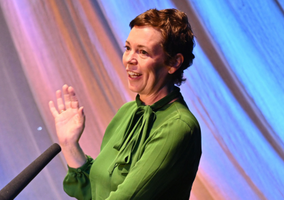Rebranding can be a costly process, but strong brands can draw in higher donations and raise more awareness for a charity’s cause.
In some cases, charities have chosen to drop names linked to problematic founders and overhaul brands when they have developed new strategies. This can help rejuvenate the charity’s image, and ultimately allow them to help more people with their work.
Nonetheless, charities are sometimes criticised for investing donors’ money in a rebrand instead of what is considered their frontline services.
And not all rebrands stand the test of time. The Royal National Institute for Deaf People (RNID) spent £260,000 on rebranding as Action on Hearing Loss for its 100th anniversary in 2011, but changed back because research involving 6,000 people found that the old name was more popular (this cost £69,000).
‘We have moved to something more modern’
Nonetheless, rebranding may take place when charities launch new strategies, as research can suggest change is needed.
Catherine Cottrell, director of marketing and income generation at Cats Protection says the charity launched its recent rebrand to support its new strategy. The charity refreshed its logo and updated its website.
“Research we did among external audiences, as well as some of our 11,000 volunteers and staff, indicated our brand was holding us back,” she says.
Some 62% of those surveyed were aware of Cats Protection and regarded it as approachable and trustworthy.
“However, we were also seen as smaller than we are, old-fashioned and less expert than we know our team of volunteers and employees to be. It was clear that our brand was not as recognised, loved or understood as it should be,” Cottrell says.
“As a result we have moved to something more modern, dynamic and contemporary to help us engage with new audiences and deepen our relationships with our existing supporters.”
The Disabilities Trust recently rebranded as Brainkind, and Richard Jane, director of external affairs at the charity, says “what really got things going at the tail end of 2022 was our new strategy to focus on acquired brain injuries and neurological conditions”.
“The visual identity itself was outdated and crucially, it wasn’t representative of the organisation we were as of 2022 or wanted to be from 2023 onwards.”
For a modern brand, it “wasn't fit for purpose for digital channels” and did not scale, he says. “We needed to build an accessible brand that was fit for use by the people we support, as well as those external audiences.”
Brainkind wants to increase provision of brain rehabilitation and care, increasing the number of beds, and new facilities. Last year, it bought three services from Sue Ryder's neurological division, and early this year it opened a neurological centre.
“To go along with that new focus, that new strategy of growth and the focusing particularly on acquired brain injury, we needed a brand which reflects our values and is representative of the audiences we're trying to reach,” says Jane.
“We need to make sure that we are a brand which is uppermost in the minds of those who commission.”
Charlotte Lore, head of communications and marketing at Centrepoint, says her charity also identified that its brand “wasn’t working as hard as it could be”.
The £150,000 brand refresh, included an updated website, logo and strapline: “Ending youth homelessness”.
The charity did “extensive” research with young people, supporters (existing and potential), trustees, and decision makers, and found that “not only did our vision and purpose not reflect our ambition, but our visual identity no longer reflected us either”.
Similarly, Catherine Anderson, executive director of the London Marathon Foundation, says her charity launched an operational strategy in 2022 to make the brand more modern and accessible for audiences, and to support it in marking a new chapter in who, what and how it funds.
It rebranded from The London Marathon Charitable Trust to the London Marathon Foundation.
‘The creative always comes last’
Though the creative element of a rebrand is important to its success, it must come after sound research and people engagement.
Jane of Brainkind says: “We did a lot of co-production with people we support to make sure that there was enough definition between some of our visual elements, the patterns we use, not just the colours but the shapes and that they mean something to people when we're trying to communicate brand positioning.”
Nonetheless, “the creative always comes last” – “the last thing you do is provide a logo and a colour”.
“That's not brand. Brand is the organisation, brand is the people who work there and the services we provide.”
Although the colours and the logos are important for recognition, “they should only be added on at the end when you have sorted out your platform, your brand positioning”.
“We went out and we spoke to all of our key audiences, staff, our colleagues, across the organisation, the people we support, some of our external stakeholders as well.”
“We've been around for a long time. We want to make sure that that legacy and the 45 years of work that we do is still built into the fabric of the brand.”
Lore of Centrepoint, says: “Our brand refresh is an evolution, not a revolution. The iconic orange and Centrepoint circle visual systems remain, but we have injected energy and the sense of a movement with the purple and transitional graphics. Our research showed this had the appeal we needed to build a movement to end youth homelessness for good, bringing young people, supporters and decision makers with us.”
Financial considerations
London Marathon Foundation was able to carry out the rebrand in-house, but many charities contract external agencies to do so.
Cats Protection worked with a design and brand agency Luke Charles to develop a logo and toolkit which, cost £50,000. The balance of the design work was carried out by the internal charity design team.
“The rebrand has been carried out with efficiency in mind and the roll-out is taking place over the next three years to ensure we can proceed in a cost-effective way,” Cottrell says.
The first phase of the re-brand identified the assets that carried the greatest impact with audiences (the main website, social media channels, adoption centres, shops and branches with high footfall) and ensured only they were switched over to the new brand.
“In the case of the shops, we re-branded the exteriors with the interiors to follow later on as part of our existing retail modernisation project. Further phases will follow which will help us to keep implementation costs to a minimum,” she says.
This means it will be running two brands side by side for a period but this is a “very natural position for an organisation of our size and scale”.
It is also approaching this rebrand in an environmentally-responsible way – “we are using up, recycling or repurposing’ materials that featured the old brand as we go along”.
Updating everything at once would have been “a near-impossible task, as well as not being responsible from a cost or environmental point of view”.
Jane says “there's two parts to the financial considerations” one being the resource needed to do the research, and then the process of creative development.
“It was a significant investment, but as a proportion of the rest of the financial decisions we make every year, it should be a very worthwhile investment. So we spend £150,000 on the research and the creative development side.”
The second part was the implementation of that, Jane says, most of which is covered by usual marketing spend.
“I think in the end the decision comes down to the cost of not doing it, so we've got a new strategy and trying to implement that new strategy without changing who we are, how we look, what we stand for and our values, we could not move forward without it.”
At Centrepoint, Lore says: “Our spend was iterative, so it started with looking at our vision and purpose, and then increased when feedback told us our vision no longer matched our ambition.
“The transition to the new brand has and remains gradual. We have only updated assets when we need to, which is why some of our old branding was used alongside the new branding initially.”
‘Ensuring engagement was a key risk’
Lore says there are always risks involved when refreshing a brand but “there are risks to doing nothing”.
“We managed the risk by ensuring every decision we made in connection to our brand refresh was done with the insight of young people, supporters and decision makers. We also held a competitive tender process to ensure we were working with experts and had the best value for money.
“We believe the brand refresh will help us reach more young people, support income generation and help us to reach people who can work with us to end youth homelessness.”
Cottrell says another risk is ensuring engagement across volunteers and employees.
“We addressed this by involving as many of them as we could in the planning stages and developing a robust programme of internal communications.
“We also did extensive market research to test out our new brand proposition which gave us an evidenced approach to support our new proposals.”
Jane's biggest tip is to involve employees in the rebrand process. “It's got to be a collaborative process with staff,” he says. “They have to believe in it. This is absolutely crucial for its success or failure.”
For the London Marathon Foundation, the main risk was around the external communication of its new name and how it would be perceived.
“However, we felt this risk was low as the unique aspect of our identity (the London Marathon) was retained in the rebrand, maintaining the connection for our existing audiences to who we are and our work,” says Anderson.
“Additionally, one of the prime objectives of the rebrand was to engage with new audiences that might not know about us and our work, so in some ways we were starting from scratch with these audiences.
“Timing was also key, and we felt this was the right time to rebrand. After the uncertain years of the pandemic which meant we had to pause new funding, 2023 was the first year where we were able to fund at pre-pandemic levels.
“As we returned to funding, our focus was to direct our funding to where it is most needed, by engaging new groups and communities which need the most support to be active. We felt the rebrand would help us to do this, acting as a vehicle for our new messaging around who, what and how we fund.”
How will you assess the success of the new brand?
Cats Protection will externally measure the success through a number of methods, including prompted and spontaneous awareness, consideration, familiarity and social media sentiment.
“Internally we will measure its success with our own people through qualitative methods, for example one-to-one interviews, focus groups and so on, as we continue to embed the brand throughout the organisation,” Cottrell says.
Over a longer period, “we will be able to evaluate the impact the new brand and associated activity has on our income generation and attraction of a more diverse supporter audience”.
Lore says: “It’s too early to measure the success so soon after launch, but we continue to evaluate key metrics like growth and engagement across social channels, and performance across our website with key audiences. We will also look at brand metrics like consideration, advantage and affinity, as well as awareness where we see greater spend in advertising in new executions at key points of the year.”
She says some charities see a dip in awareness and recognition when they launch a new visual identity, but Centrepoint has not seen any dip, despite not investing in brand activation or advertising at launch.
“In fact, we have seen some growth in awareness and consideration, as well as improved performance across our social channels and website.”
Anderson says: “At the heart of any rebrand should be how the updated identity will enable better delivery of objectives. For the foundation, one of the key purposes behind our rebrand was to connect new groups and communities with our funding, supporting those who may not have heard about our funding or known that they could apply to us.”
In 2023, she says, 74% of the organisations London Marathon Foundation funded were organisations it had not previously funded.
Jane at Brainkind advises: “Don't be shy in your brand” as charities are competing with all sorts of corporations – “we have to get that cut through, you have to be a competitive brand”.
Indeed, in this economic environment, charities have to decide wisely how to use their resources. But ultimately, strong rebrands can draw in more money and awareness. Nonetheless, thorough brand research is needed to make the right move.
Related Articles












